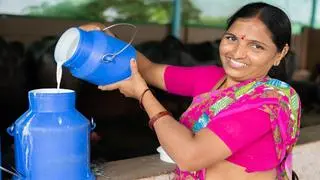India targets becoming a global manufacturing hub and spawning high-tech innovation laboratories. Post the Covid-19 pandemic, the country is also poised to promote traditional medicine. That calls for a larger and efficient patent office, to avoid fighting intellectual property claims, as happened with turmeric.
India aims to be among the top 25 on the global innovation index of the UN’s World Intellectual Property Organization. Its ranking improved from 81 in 2015 to 40 in 2022. The 2022 index ranks India first in patent applications in the ‘lower-middle income’ category and Central and South Asia. The number of patents filed has increased more than 50 per cent since 2015 — from 42,763 to 66,440.
The number of domestic filings by Indian applicants has, for the first time in 11 years, surpassed those filed by non-Indians. Also, the number of patents granted in 2021-22 stands at 30,074, compared with 5,978 in 2014-15.
India desires to become an upper-middle income economy by 2047, a trillion-dollar digital economy by 2026, and a $10-trillion national economy by 2034. It is also a leading contender for membership in the expanded or reformed UN Security Council. But ‘national security’ cannot be seen solely in the context of military strength but also technological capabilities, domestic security, foreign policy, and economic security. To address these, India must eye not only the Security Council but also another distinct group of five, the top five IP filers of the world.
Innovate, collaborate
In 2007, the Korean Intellectual Property Office, Japan Patent Office, China National Intellectual Property Administration, the European Patent Office, and the United States Patent and Trademark Office collectively formed the IP-5. They account for more than 80 per cent of global patent applications and 95 per cent of applications filed under the Patent Cooperation Treaty of 1970.
The IP-5 engages in harmonising the voluminous patents filed among them and promoting a user-friendly, cost-effective, and efficient international patent landscape. The IP-5, including Germany and the Netherlands, has championed technologies like computers, precision instruments, audiovisual devices, digital communications, medical instruments, transportation, energy devices, and electrical machinery.
India is sure to become an active patent applicant in these domains, but this calls for competitiveness in raw material supply chain, R&D, global finances, and regulating high-end manufacturing. India needs such dexterity to become an international champion of innovations, say from Industry 4.0. Therefore, a larger patent office must not only be seen as one that efficiently churns out IP but also functions as India’s sentinel, watching the international IP governance landscape that feeds into the nation’s geostrategic decision-making.
India seldom made such efforts during the past 75 years. It is perplexing that despite its vast presence in India for long, the United Nations has never set up a WIPO external office here. On the other hand, the WIPO runs external offices in Algeria, Brazil, China, Japan, Nigeria, Russia, and Singapore outside its headquarters in Geneva. The WIPO is a specialised agency of the United Nations Economic and Social Council (UN-ECOSOC), one of the six principal organs of the UN. India had a significant role in its establishment.
The India connect
A less known fact is that the UN-ESOSOC’s first president was an Indian — Arcot Ramasamy Mudaliar, the last Diwan of Mysore and a member of the Viceroy’s Executive Council of India. Mudaliar used his position as council member to establish the Council of Industrial and Scientific Research (CSIR) in 1942. Today, CSIR’s labs are among the top patent applicants in India. Mudaliar was ECOSOC’s president twice — in 1946 and 1947.
It was only much later, in 1990, that an Indian — the diplomat Chinmaya Gharekhan — again headed this body; neighbouring Pakistan has presided over ECOSOC six times.
India will undoubtedly need a larger patent office peopled by innovation analysts and technocratic diplomats representing the country’s interests and worldviews in various IP bodies. Only then will we be able to pull up a chair to the IP-5’s high table.
(The writer is Space Domain Consultant, Research and Information System for Developing Countries, New Delhi. Views are personal)








Comments
Comments have to be in English, and in full sentences. They cannot be abusive or personal. Please abide by our community guidelines for posting your comments.
We have migrated to a new commenting platform. If you are already a registered user of TheHindu Businessline and logged in, you may continue to engage with our articles. If you do not have an account please register and login to post comments. Users can access their older comments by logging into their accounts on Vuukle.